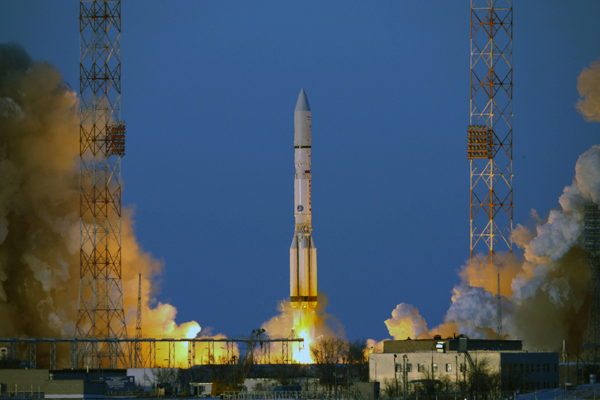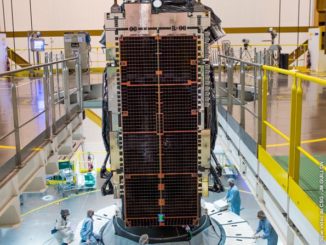
A commercial satellite launched Sunday on a Russian Proton rocket successfully deployed in orbit thousands of miles above Earth to join Inmarsat’s new communications network providing high-speed data links between airplanes, ships and far-flung customers anywhere in the world.
The Inmarsat 5 F2 spacecraft is the second satellite for Inmarsat’s $1.6 billion Global Xpress system, a next-generation network designed to enable faster communications speeds for the London-based company’s customers.
The 6.7-ton satellite blasted off at 1231 GMT (7:31 a.m. EST) from the Baikonur Cosmodrome in Kazakhstan and rocketed northeast on top of a 191-foot-tall Proton launcher, which shed its six-engine first stage about two minutes into the mission.
The Proton’s second and third stages finished their engine burns less than 10 minutes after launch, and a hydrazine-burning Breeze M upper stage took over for a series of five perfectly-timed maneuvers over the next 15 hours to inject the Inmarsat spacecraft in orbit.
The mission was targeting a “supersynchronous” transfer orbit with a high point of 65,000 kilometers — more than 40,000 miles — above Earth. The orbit’s intended perigee, or low point, was at an altitude of 4,341 kilometers — or 2,697 miles — and an tilt of 26.75 degrees to the equator.
Spacecraft separation occurred at 0402 GMT Monday (11:02 p.m. EST Sunday), and International Launch Services declared the launch a success.
Based in Virginia, ILS is in charge of arranging commercial satellite launches on Russia’s Proton rocket. ILS is a subsidiary of the Moscow-headquartered Khrunichev State Research and Production Space Center, which manufactures the Proton and Breeze M launch vehicle.
“It is a true honor for ILS and Khrunichev to be entrusted with the launch of the Global Xpress network for industry innovator, Inmarsat,” said Phil Slack, president of ILS. “The Inmarsat 5 F2 launch will enable ground breaking satellite communications connectivity via land, sea and air, as part of the three-satellite system launched by ILS Proton.”
Sunday’s launch was the first of 12 planned Proton mission in 2015. Five or six of the launches are assigned to ILS for deployments of commercial communications satellites like Inmarsat 5 F2, an ILS spokesperson said.
The Inmarsat spacecraft was built in El Segundo, California, by Boeing Satellite Systems International, and it carries its own chemical and electric propulsion system to maneuver into a circular orbit 22,300 miles over the equator in the coming weeks, where Inmarsat will complete testing of the platform and begin using it for commercial service.
The Inmarsat 5 F2 satellite is about the size of a London double-decker bus, and it will extend power-generating solar panels to a span of 111 feet by the end of the month, Inmarsat said in a press release.
The satellite should be on station in geostationary orbit by the end of March, Inmarsat said, and begin payload testing in early April.
Furnished with 89 fixed and steerable spot beams, the satellite will be the second craft to launch for Inmarsat’s Global Xpress service, which aims to boost connectivity speeds for customers on airplanes, at sea, and in other remote regions worldwide.
“The successful launch of our second Inmarsat 5 satellite by Proton is a significant step forward on our journey to deliver the world’s first globally available, high speed mobile broadband service,” said Rupert Pearce, CEO of Inmarsat.
“This is a great achievement and I would like to pay tribute to the skill and expertise of Inmarsat’s engineering teams and all our employees involved in the design, development, manufacturing, testing and launch,” Pearce said. “It is their dedication, alongside the outstanding support we have received from our manufacturing and launch partners – Boeing and ILS – which has helped deliver such a successful outcome.”
Inmarsat’s previous satellites broadcast in L-band frequencies, but the company switched to Ka-band for the Global Xpress system, offering improved downlink communications speeds to 50 megabits per second, with up to 5 megabits per second on the uplink side.

And users can link up with the Global Xpress satellites with smaller terminals, easing restrictions on antennas size for customers on the go.
“Global Xpress is a truly transformational technology and, as we complete its global rollout, 2015 promises to be one of the most significant chapters in our company’s history,” Pearce said in a statement. “Through Global Xpress, the world can move forward from the ‘Internet of Everything’ to the ‘Internet of Everywhere,’ in which high-speed, reliable and secure connectivity is available anywhere and at any time — even in the most inaccessible regions — for customers on the move or to fixed locations.”
Inmarsat counts maritime operators and airlines among its customers, allowing ships and planes to remain connected while traveling through remote oceans and skies.
The improved broadband connections will give airline passengers more options for entertainment and work while in the air, and could help air traffic controllers and airlines track the status of jumbo jets flying outside the reach of terrestrial radars.
Such a capability became vogue after the loss of Malaysia Airlines Flight MH370 in March 2014. Inmarsat engineers tracked ping signals the company’s satellites received from the lost airliner and helped investigators conclude the plane likely went down somewhere in the southern Indian Ocean.
No trace of the jet has been found.
Inmarsat proposed a free global airplane tracking service in May 2014 for all commercial airplanes fitted with the the company’s satellite transmitters.
Inmarsat’s first Global Xpress satellite launched in December 2013. Launches of the next two spacecraft were delayed after a Proton launch failure in May 2014 that left the booster grounded for four months.
Russia sent up two government missions on Proton launches in September and October before the rocket returned to commercial service with a pair of flights for Gazprom Space Systems and SES in December.
The Inmarsat 5 F1 spacecraft deployed in December 2013 covers the Indian Ocean, the Middle East, Europe and Africa. The satellite launched Sunday will be positioned at 55 degrees west longitude over the Atlantic Ocean and the Americas.
The third Global Xpress satellite has completed ground testing and is due for liftoff in the second quarter of 2015, allowing Inmarsat to commence global service by mid-year. Boeing is manufacturing a spare fourth Inmarsat 5 satellite, with delivery expected in late 2016.
But Inmarsat’s clients are already using the Global Xpress system.
“Our first GX satellite entered commercial service in July 2014 and has since been delivering an excellent service to our customers in Europe, the Middle East, Africa and Asia,” Pearce said. “With Inmarsat 5 F3 expected for launch by Proton in the coming months, we are on schedule to achieve full global coverage early in the second half of 2015.”
Britain’s Sky News broadcasted the first live, on-air transmission through Global Xpress to support the networks’s coverage of the Jan. 25 Greek election.
“GX represents a significant opportunity for media,” said Martin Turner, director of media at Inmarsat Enterprise, in a press release. “The ability to live stream HD content to news-hungry audiences worldwide is crucial in a competitive industry and we are proud to be able to deliver a service that enables the world’s media to do just that; no matter how remote their location. Reliability, speed and quality are of unique importance to our media customers and we will continue to deliver on these areas, supported by a suite of terminals, when the GX network becomes fully operational.”
Follow Stephen Clark on Twitter: @StephenClark1.



